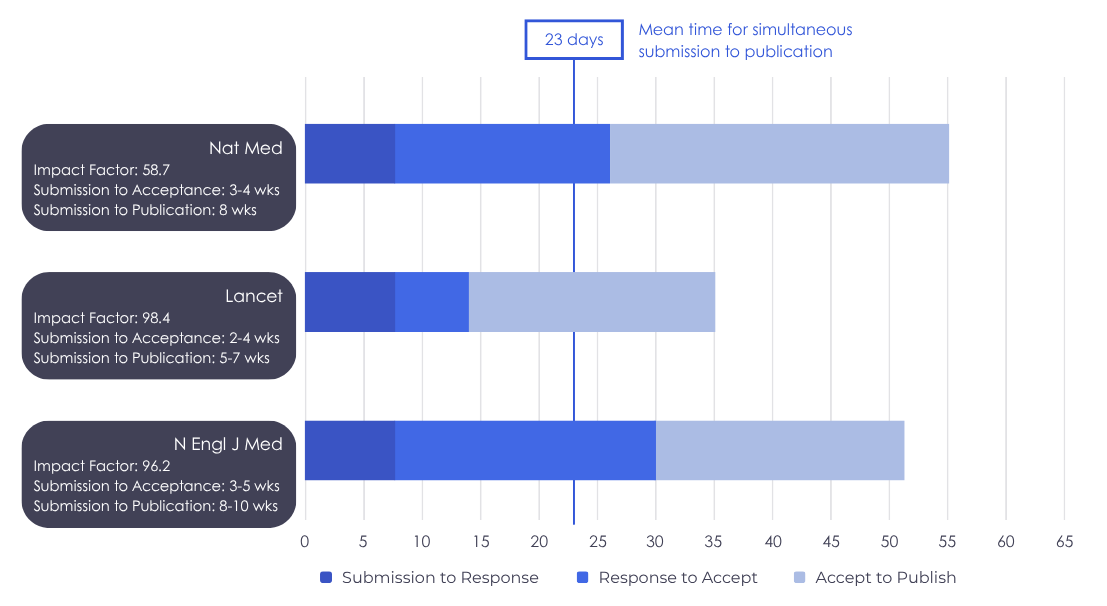Aligned for Impact: Publishing in Parallel
In the evolving landscape of scientific communication, simultaneous publication has emerged as a strategic priority for many of our clients. Publishing a peer-reviewed manuscript in tandem with presenting data at a major medical congress offers a powerful opportunity to maximize visibility, reinforce scientific credibility, and accelerate the uptake of key findings. As competition for attention intensifies, simultaneous publication is no longer a nice-to-have, but a critical component of an integrated data communication strategy. Yet, achieving success is resource-intensive, requires precise timing, seamless cross-functional collaboration, and a clear, forward-looking plan.
ApotheCom is one of the most trusted Med Comms agencies in publication strategy. We’re experts in delivering simultaneous submissions aligned with pharma and biotech brand strategy. In this insight by Claudia Piano, Executive Vice President, Client Services; Donna Kelley, Senior Director, Client Services; and Paul Sobol, Vice President, Scientific Partners, we uncover what simultaneous publication really means, why it matters, and how to do it right.
What Is Simultaneous Publication?
Simultaneous, or parallel, publication refers to the concurrent release of a peer-reviewed journal article and the public presentation of the same core data at a congress, via a poster or oral presentation. This practice has become so prevalent that many journals and scientific congresses now offer explicit guidelines and submission pathways to accommodate it.
Why Does Simultaneous Publication Matter?
When executed well, simultaneous publication can be a game-changer. Here is why:
- Maximized Exposure: Data are amplified across two channels, boosting reach, engagement, and online activity
- Stronger Congress Presence: Peer-review feedback on the manuscript can help pre-emptively address potential questions at the congress
- Faster Access to Science: Clinicians and stakeholders get immediate access to full study details, which supports transparency and enhances clinical decision-making
- Doctor–Patient Dialogue: A published article can serve as a credible resource for patient education and informed discussions
The Challenges You Will Need to Navigate
Let us not sugarcoat it. Simultaneous publication is not easy. The path is filled with logistical hurdles:
- Tight Timelines: Coordinating data readouts, abstract deadlines, and manuscript submission windows is no small feat
- Resource Pressures: Writing, reviewing, and approving documents on an accelerated schedule strains even the most prepared teams
- Peer Review Surprises: Reviewers may request additional analyses, potentially delaying timelines
- Rejection Risks: Not all manuscripts make it through the journal review process in time
- Stakeholder Juggling: Balancing the needs of authors, journals, sponsors, and congress organizers requires near-constant communication
ApotheCom’s Impact with Simultaneous Submissions
ApotheCom has successfully coordinated multiple simultaneous publications in high-impact factor journals aligned with major congresses.
Average Timing Based on APO Simultaneous Publication Experience:

Not all journals follow the same timelines or offer clear guidance on simultaneous publication. While many now provide pathways for parallel publication, others do not—making clear communication with the journal essential to determine feasibility and potential for expedited review.
Top-tier journals like New England Journal of Medicine and The Lancet have clear pathways for rapid or fast-track submissions, which help guide planning. However, some journals like Nature Medicine may not publish explicit fast-track policies. In our experience, this doesn’t mean they’re off the table.
Engage early. Nature Medicine has accepted 3 of our publications with a pre-submission inquiry submitted ~12 weeks before the congress, with the full manuscript due ~8 weeks before publication—highlighting that asking the question early can open doors.
The takeaway? Know your target journal’s processes and requirements early and plan accordingly.
What Makes a Simultaneous Publication Successful?
Behind every successful simultaneous publication is a rock-solid plan. Here are the must-have components:
Strategic Scenario Planning
- Begin with long-lead planning and clear scenario mapping based on unblinding timelines, congress deadlines, and journal review windows
Cross-Functional Collaboration
- Maintain tight alignment with the study team, authors, and publication leads
- Set up adjudication calls before and after submission to expedite review and decision-making
Dedicated Writing Team
- Engage a seasoned writing team that can work across time zones and develop a manuscript shell early
- Incorporate peer reviewer feedback quickly and efficiently
Deadline Management
- Monitor key dates: data readouts, abstract submissions, manuscript deadlines, and SEC press releases if applicable
- Have backup journals and contingency plans ready
When Timing Does Not Work Out
Not every simultaneous publication goes according to plan, and that is okay. If timelines slip, here are a few alternatives:
- Submit to a More Flexible Journal: Some lower-tier journals or those with rolling submission windows may be more accommodating
- Opt for Fast-Track or Rapid Review: Several journals offer expedited review for late-breaking or high-priority data
- Publish Post-Congress: A regular submission after presentation can still provide significant value
Final Thoughts
Simultaneous publication is a powerful way to showcase cutting-edge science when it matters most, but it requires foresight, coordination, and a deep understanding of the publication landscape.
At ApotheCom, we bring the experience and expertise to guide clients through every twist and turn. Whether you are planning your first parallel publication or looking to refine your approach, we are here to help make it happen. Reach out to us today.
Other similar insights
Jump to a slide with the slide dots.
Inclusive Medical Communications: A Strategic Imperative for Industry Sustainability and Growth
Inclusion has too often been siloed as a moral imperative – crucial for addressing health inequities, but not a central factor in driving innovation a
Read moreOur Commitment to Ethical and Transparent Publication Practices: ApotheCom and ISMPP
As a leader in medical communications, ApotheCom is deeply committed to upholding ethical and transparent publication...
Read moreThe Value of User Research for digital engagement in Medical Affairs and Pharma
User research is critical to the success of digital initiatives. Whether developing an HCP portal, or a patient...
Read more